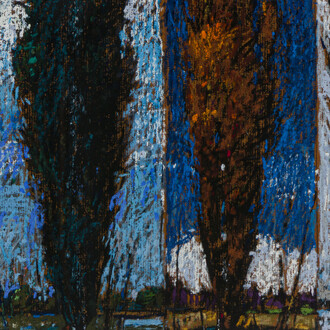Multimedia artist Kim Eubank showcases Pop Art-inspired paintings of Pax Americana.
Tales from the edge of Americana is an exhibition of mixed media paintings and monoprints by Kim Eubank that depict archetypal scenes of Postwar America such as the happy, yet stoic, nuclear family; kids playing behind the white picket fence of the quintessential suburban home; or a child bewitched by a cathode television, whose flowers wither as she is consumed by America’s newest media addiction. Charming, melancholic, and folkloric, these works convey the evolution and social byproducts of America’s social contract and an unarticulated tension surrounding the slow decay of Pax Americana. Tales from the edge of Americana opens on October 31 from 5 to 7 PM in the gallery’s atrium.
In this forthcoming exhibition, life appears peaceful but feels unsettlingly numb. Since 2015, Eubank has created large-scale, figurative paintings of domestic scenes in her Madrid studio in New Mexico. Using building materials such as tar paper, wood panels, and aluminum, Eubank evokes in her work the large, sprawling Ranch-style homes that became a symbol of social mobility and prosperity in Postwar America as well as the de facto setting where Americans celebrated the hard-won joys of convenience and leisure but also suffered unanticipated social externalities such as increasing isolation and rigid gender hierarchies. Equally informed by the aesthetic sensibilities and philosophical considerations of Pop Art, Eubank’s paintings present viewers with an uncanny vision as well as erosion of Pax Americana.
“While they are not overt sociopolitical critiques, Eubank’s works do share that quality of American folk art identified by art scholar Lynette I. Rhodes as images that ‘derive from the life, concerns, and aspirations of ordinary people, and as such reflect the underlying life patterns of a culture as a whole.’ One feels an unsettling mix of familiarity and anxiety in these vaguely surreal renditions of archetypal scenes from America’s cultural consciousness. Eubank’s figures are safe, free to play and consume, and yet they are adrift, literally and metaphorically, with little to fix their purpose or identity to,” notes Spencer Linford, form & concept communications and marketing director.
“If the figure that figures prominently in Eubank’s paintings is that of the quintessentially American,” form & concept Director, Carina Evangelista, states, “it’s the kind that feels lifted from mid-century children’s book illustrations sieved through a screen of doubt and aporia.” She adds, “A boy in a cheery lemon-patterned shirt and a girl in a dress dotted with daisies play with a rocket ship toy, alluding to the duck-and-cover school drills during the Cold War. Iconic women identified with strength, Rosie the Riveter and Wonder Woman, flex their power in domestic chores. Vintage U.S. maps and cursive handwriting templates add texture to compositions with boats that suggest the still waters at the edge of Americana harbor the mysteries of connection or alienation in family lives. The bright Pop colors wax acrid but not all is mordant. Hands clutch posies. There are monoprints of honeybees–Eubank’s homage to her grandfather who engendered the love of beekeeping in his family. A child with wings is poised for liftoff.”













